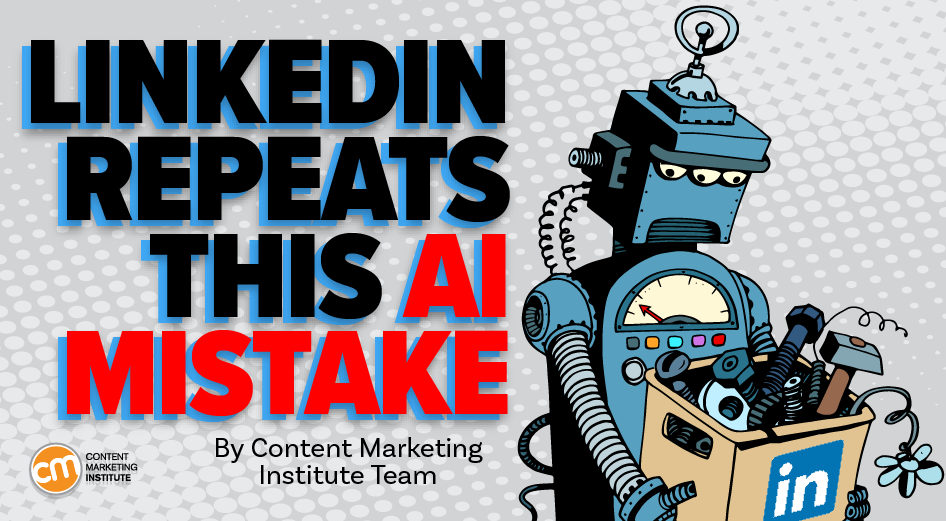
An update to terms of service isn’t usually a headline-making event, even at the biggest brands.
Yet, this past year tells a different story.
In June, Adobe got into hot water for scraping content to use for its AI-learning models and then changing its terms of service to allow it. Weeks earlier, Meta went through a similar challenge when it changed the terms of its privacy policy to allow the use of customers’ data in its AI-learning models. In August 2023, Zoom faced criticism for its updated terms of service around AI training and then had to write a blog article to clarify its plans.
Did all those headlines serve as a cautionary tale for other big brands to stay clear of an AI-related terms-of-service controversy? Ask LinkedIn.
The social media darling of the B2B world has come under fire this month for automatically opting users into a program that trains generative AI models with their data. Some LinkedIn users weren’t happy to learn of the change.
So, we asked Robert Rose, CMI’s chief strategy advisor, for his take. What he says is the reason for the outcry may surprise you. Read on or watch the video:
LinkedIn’s terms of service turns heads
Is the fuss warranted? Do you care that LinkedIn is using your content on LinkedIn to make LinkedIn more LinkedIn-y? Or, as my wife says, is it that “It’s not the thing. It’s the principle of the thing?”
404 Media broke the story about AI content-mining and reported that LinkedIn would update its terms of service “shortly.”
Once the company made the change, the terms of service included this passage (as many do today):
“We may use your personal data to improve, develop, and provide products and Services, develop and train artificial intelligence (AI) models, develop, provide, and personalize our Services, and gain insights with the help of AI, automated systems, and inferences, so that our Services can be more relevant and useful to you and others.”
I translate that to: “We use your data to make things better and teach computers to help make our services more useful for you and other people.”
However, the problem doesn’t seem to be the fact that LinkedIn added this section to its terms of service or even that it requires users to opt out rather than opt in to the program.
This is the real reason LinkedIn got in trouble
The criticism comes from LinkedIn seemingly updating the terms of service after it started doing it, as Tech Crunch reported last week.
What’s going on among legal, marketing, and corporate communications teams? I don’t understand why these things aren’t better coordinated, even at a company the size of LinkedIn.
They should have learned from the public fails at Zoom, then Meta, and most recently Adobe.
You see, the problem isn’t that LinkedIn is using customer data. Most people should assume companies are going to do this.
And isn’t the whole point of your LinkedIn content to have everybody see it, learn from it, and value it? Wouldn’t anything that helps you shape the ultimate content to your point of view about the world on LinkedIn be a net positive?
I get not wanting pictures of your kids, family, and home, or your private messages on Facebook to educate Meta’s AI, but LinkedIn is different. Or am I missing something?
OK, back to the real takeaway. The bad optics happened because these brands failed to communicate to their existing audiences. Blundering seems to plague these companies.
You may have missed the terms-of-service news because LinkedIn was quiet about it. But I’m sure you noticed the ham-fisted AI prompts that appeared under LinkedIn posts as “suggested comments.” They’re now gone after LinkedIn heard the clamor from users about the ridiculousness of these prompts. This new AI data update move seems like LinkedIn’s trying to make the platform smarter to either return a newer and better version of suggested comments or offer new AI-generated features.
Expect more of the same, hope for better communication
The lesson is that this is inevitable. Platforms will use your behavior and your content to learn how to engage more deeply and motivate you to use it more heavily.
Today, it’s Netflix, Adobe, Google, Meta, and LinkedIn. Tomorrow, it’s your business software provider, your airline, your favorite hotel chain, your bank, or your health-care provider.
Let’s just hope those companies will have learned the lesson so they coordinate their content, AI learning, and messaging a bit better. As I’ve said for years, 90% of an intelligent content strategy has nothing to do with the content; it’s the coordination and collaboration of how you communicate to the world.
Perhaps, like using daylight saving time as a reminder to change your smoke alarm batteries twice a year, you can use a platform’s change of its terms of service as a reminder to check on your content strategy.
HANDPICKED RELATED CONTENT:
Cover image by Joseph Kalinowski/Content Marketing Institute
